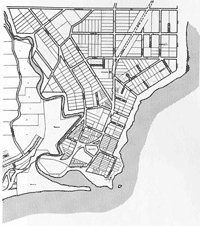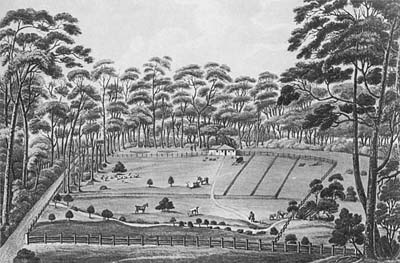In the third exhibit we learned how the first Europeans in Australia saw the land through the cultural and socio-economic lenses of their European experience. Soon after the first heady months of settlement turned into years, letters sent home to England speak less of noble park-like landscapes and more of bleak and gloomy wilderness, infertile soil, low rainfall, deadly snakes, and unfriendly natives. The natives were believed to be of the stone-age, and child-like, with no knowledge whatever worth acquiring. Clearly the land seemed a chaotic and hostile wilderness upon which civilised man would have to impose order, value and meaning.


4.8
Joseph Lycett, Fishing by torchlight, c. 1819
Watercolour, 17.5 x 28 cm
National Library of Australia
This view could not be in greater contrast with that of the original inhabitants for whom every feature of the land was already charged with meaning according to a precise order established in the dreamtime and confirmed in daily interaction with the natural environment.
Perhaps no more dramatic contrast between the two cultural perspectives on nature can be found than in the reaction to bushfire. Australia is perhaps the most fire-prone of all continents. In the European-Australian painting (ITEM 4.9) fire is a terrifying menace, unnatural, a hell, a chaos, disorder and destruction. In the Aboriginal view (ITEM 4.10) below, fire forms part of a gentle peaceful scene, not threatening, but within the order of nature. Of course, fires in nature do in fact range from the holocaust to the 'cool burn’, but the attitudes described here are those each culture generalises.
Little did the early settlers know, and indeed only recently have ecologists begun to suggest, that the open woodlands, free of underbrush, which the first colonists described as gentlemen's parks, had resulted from Aboriginal husbandry of the land. Through regular and controlled firing of the land, Aboriginals had established fire breaks early in the dry season, and thus rejuvenated the growing cycle of the natural flora. This was by no means indiscriminate burning: certain plants and human habitations were protected. Wherever the Aboriginal people did not live, or had been driven off or killed, or had died of imported disease, it has been suggested that the woodlands tended to grow a dense understory, providing kindling for calamitous fires, such as those experienced in Gippsland (1898) and most recently throughout Victoria and South Australia on Ash Wednesday, 1983. However the ecology of fire in Australia is still a matter for debate. When the anthropologist Rhys Jones once asked some Aboriginals why they burned the land, they responded: 'More better, we clean this country'.

4.9
Sir John Longstaff, Gippsland, Sunday night, 1898
Oil on canvas, 196.2 x 143.5 cm
National Gallery of Victoria
Purchased 1898

4.10
Dick Roughsey, Bushfire approaching, n.d.
Acrylic, 40 x 50 cm
Private collection

4.11
Survey map, township of Airey's Inlet, Victoria Based on a map provided by the Barrabool Shire Council, 27.6.73
The order which Europeans imposed on the land was a geometric grid, bearing little relationship to the natural features or the ecological realities. The sub-divisions of Airey's Inlet, though considered by it inhabitants a 'bush retreat’, reflect the shire engineer's T-square and drawing board rather than the flood plain of the river, the steep slopes of the Otway foothills, or the dunes and cliffs of the shores of Bass Strait.

4.12
Anon, The surveyor, 1876
Engraving
Hidden in the dense Gippsland rainforest stands a potent symbol of the reordering of the natural environment. Today the few remaining pockets of this forest are threatened by the economic interests of the new order.

4.13
C.G.S. Hirst, Claremont House, 1881
Pen, ink and watercolour, 54.5 x 89 cm
National Library of Australia
(Claremont House is the residence of Mr George Bashford and family at Limestone, near Ipswich, Oueensland)

4.14
Joseph Lycen, Raby. A farm belonging to Alexander Riley Esqr. New South Wales, c. 1824-5
Aquatint
From Joseph Lycen, Views in Australia or New South Wales and Van Diemen's Land delineated, London, 1824-5
Fences formed both the physical and symbolic structure of the European conception of order. Fences imposed on the landscape a new kind of distinction relating to individual ownership; that is to say, they defined and enforced the concept of property, a legal and economic notion, unrelated to nature except perhaps in some distant sense to animal territoriality. In early Australia, fences did not so much divide one neighbour from another as to draw a line between wilderness and civilisation, between the wild and the tame, between nature and culture.